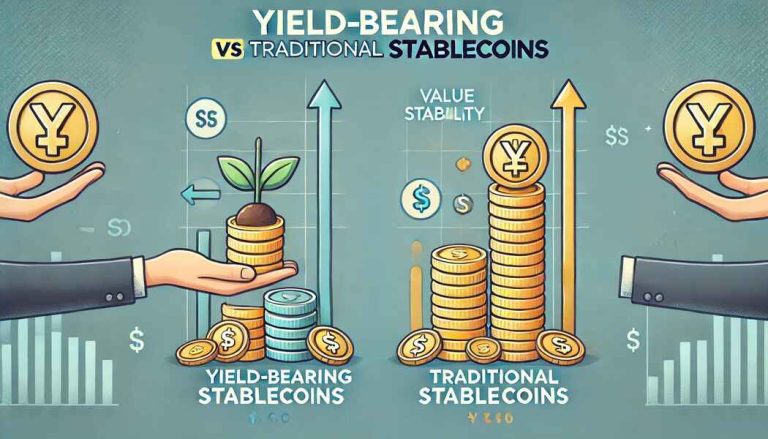Stablecoins have become a cornerstone of the crypto ecosystem, offering users a way to maintain value without the volatility typical of cryptocurrencies. However, not all stablecoins are created equal. In recent years, a new category has emerged: yield-bearing stablecoins. These offer more than just price stability—they generate passive income. In this guide, we’ll break down the key differences between yield-bearing and traditional stablecoins and help you understand how to choose the right option for your financial goals.
What Are Traditional Stablecoins?
Stablecoins, or traditional stablecoins, are digital assets that maintain a constant value by being pegged to a reserve asset. This is usually the US Dollar. Examples include:
- USDC (USD Coin)
- USDT (Tether)
- BUSD (Binance USD)
Key features of traditional stablecoins:
- Price Stability: Always aiming for a 1:1 peg with the USD or another fiat currency.
- Low Risk: Minimal fluctuations compared to other cryptocurrencies.
- Liquidity: Easily tradable across exchanges and platforms.
- Use Cases: Payments, trading pairs, remittances, and hedging against volatility.
However, traditional stablecoins typically do not offer any returns unless users manually engage in lending or staking activities on external platforms.
What Are Yield-Bearing Stablecoins?
As the name implies, yield-bearing stabilitycoins are stablecoins which generate yield automatically for holders. They integrate interest-earning mechanisms directly into the token structure or through protocols managing underlying assets.
Examples include:
- aUSDC (Aave’s interest-earning USDC)
- sDAI (Savings DAI through MakerDAO’s DSR – DAI Savings Rate)
Key features of yield-bearing stablecoins:
- Automatic Earnings: Users earn passive income simply by holding the token.
- Protocol-Integrated Yield: Interest is generated via lending markets, DeFi strategies, or staking rewards.
- Compound Growth: In many models, earnings are auto-compounded over time.
- Same Peg: Still aim to maintain a 1:1 peg with fiat currency.
Yield-Bearing vs Traditional Stablecoins: Key Differences
| Feature | Traditional Stablecoins | Yield-Bearing Stablecoins |
| Primary Purpose | Value stability | Value stability + yield generation |
| Risk Level | Lower | Slightly higher (due to protocol risks) |
| Earning Potential | Requires manual action | Earns automatically by holding |
| Use Cases | Trading, payments,and hedging | Passive income, savings, yield strategies |
| Examples | USDT, USDC, BUSD | aUSDC, sDAI, Anchor’s UST (historic) |
| Underlying Mechanism | Fully backed by reserves | Backed + integrated DeFi earnings |
Why Is Yield-Bearing Becoming a Trend?
As DeFi grows and users become more comfortable with blockchain-based finance, there is a strong demand for assets that do more than just hold value. People want their digital assets to work for them—even while sitting in a wallet.
Factors driving the yield-bearing trend:
- Inflation Concerns: Investors seek returns that outpace inflation.
- DeFi Maturity: Safer and more robust lending markets now exist.
- User Convenience: Yield-bearing stablecoins eliminate the need to actively stake or lend manually.
- Increased Adoption: Integrations are easy with platforms like Aave, Compound, and MakerDAO.
Things to Consider Before Choosing Yield-Bearing Stablecoins
Although stablecoins with yields can be attractive, there are also some considerations:
- Smart Contract Risk: DeFi protocol security is essential to the safety of funds.
- Liquidity Risks: Some platforms may impose withdrawal limits or delays.
- Regulatory Risks: Evolving regulations could impact how stablecoins operate.
- Yield Variability: Interest rates are subject to change depending on market conditions.
Always do thorough research, consider diversifying, and use reputable platforms when holding yield-bearing assets.
Final Thoughts
The choice between stablecoins with yield and traditional coins depends on the risk you are willing to take, your investment goals, and intended usage. If you prioritize maximum safety and simplicity, traditional stablecoins like USDC or USDT are ideal. However, if you want to earn passive returns while maintaining value stability, exploring yield-bearing options like aUSDC or sDAI could be a smart move.
As DeFi continues to innovate, yield-bearing stablecoins will likely become a bigger part of crypto portfolios, offering users the best of both worlds—stability and growth.
Want to optimize your stablecoin strategies?
Platforms like Coinrule allow you to automate crypto trading, including managing yield-bearing assets with ease. Start building your smart trading rules today!
Follow Our Official Social Channels:
